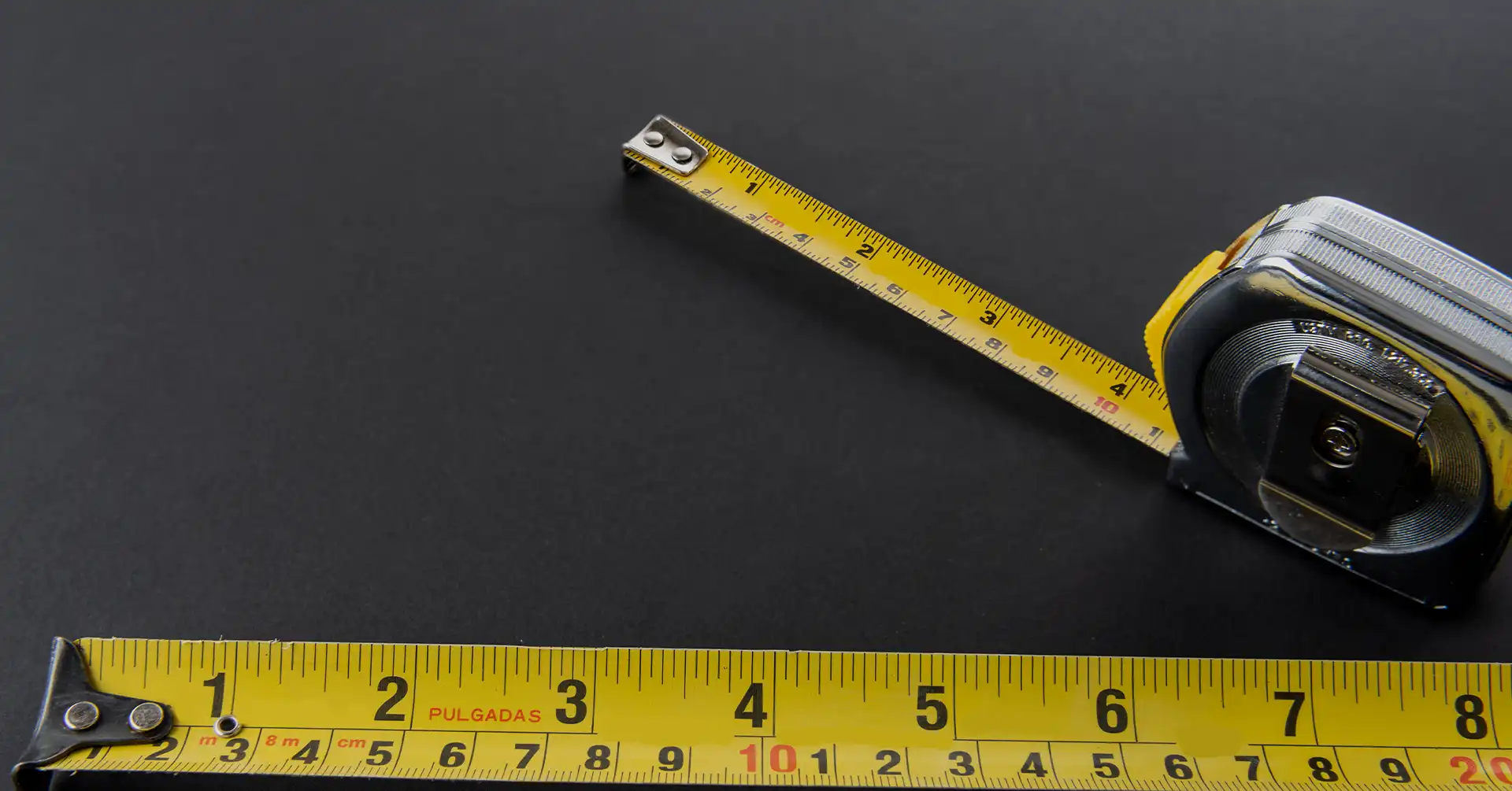A Tape Measure Marks is more than just a coiled ribbon of numbers. It’s a versatile tool designed for precision. Let’s delve into the key aspects of understanding and utilizing this seemingly simple yet crucial instrument.
Unveiling the Purpose of a Tape Measure
At its core, a tape measure serves as a portable ruler. Its design, with increments of measurements marked along its length, enables users to quantify and assess lengths accurately. This tool is invaluable in various applications, from carpentry and construction to sewing and crafting.
Why Tape Measure Marks Matter:
Tape measure marks are not mere lines on a strip; they encapsulate the essence of measurements. By understanding and interpreting these marks correctly, one unlocks the true potential of the tape measure.
Emphasizing the Importance of Accurate Measurements
Precision matters. In the realm of construction, inaccurate measurements can lead to costly errors. Whether it’s cutting materials, determining spatial requirements, or aligning components, the reliability of a project often hinges on the accuracy of measurements taken.
The Role of Tape Measure Marks in Accuracy:
Tape measure marks are the language of precision. Each mark represents a specific length, and the careful attention paid to these markings ensures that measurements are spot-on. Accuracy begins with deciphering the subtle nuances of these marks.
Anatomy of a Tape Measure
Main Components
A tape measure is not just a simple tool; it’s a precision instrument composed of various essential parts working together seamlessly.
Lock Mechanism:
The lock mechanism is a crucial component that ensures the tape remains in place once extended. To use it effectively, simply engage the lock to prevent the tape from retracting, allowing for accurate measurements.
Tape Blade:
The tape blade is the flexible, extendable part of the tape measure. It’s marked with tape measure marks that indicate units of measurement. Understanding these markings is key to obtaining precise measurements.
Case:
The case houses the tape blade and protects it from wear and tear. Sturdy cases enhance the tape measure’s durability and longevity, safeguarding its accuracy over time.
Belt Clip:
Many tape measures come equipped with a belt clip for convenient transport. This feature allows easy access to the tool, making it readily available whenever needed.
End Hook:
The end hook is the metal tip at the end of the tape blade. It’s designed to hook onto the edge of the object you’re measuring, ensuring accuracy by providing a secure starting point.
Types of Tape Measures
Tape Measure Lengths:
Tape measures come in various lengths, from compact pocket-sized versions to longer models suitable for construction projects. Choosing the right length depends on the specific task at hand.
Retraction Mechanism:
There are manual and automatic retraction mechanisms. Manual ones require manually winding the tape back into the case, while automatic ones retract with the push of a button. Each type has its advantages, depending on user preference and application.
Specialized Tape Measures:
Some tape measures cater to specific needs, such as those with magnetic tips for measuring metal objects or those with extra-wide blades for stability over longer distances.
Understanding Units of Measurement
Imperial vs. Metric Systems
Tape measure marks are the key to decoding measurements, and understanding the units used is equally crucial. The two primary systems are the imperial and metric systems.
Imperial System:
In the imperial system, measurements are expressed in inches, feet, and fractions. Tape measure marks on the blade will be calibrated accordingly, facilitating precise readings based on this system.
Metric System:
On the other hand, the metric system employs millimeters, centimeters, and meters. The tape measure marks in this system allow for accurate measurement in metric units, providing a straightforward alternative to the imperial system.
Converting Measurements
Flexibility is essential when working with measurements in different systems. Converting between imperial and metric units might be necessary in various situations.
Conversion Techniques:
Understanding simple conversion techniques can streamline the process. For example, converting inches to centimeters involves multiplying the measurement by a conversion factor.
Dual-Marked Tape Measures:
Some tape measures come with dual markings, displaying both imperial and metric units on the same blade. This feature eliminates the need for constant conversion, enhancing efficiency and reducing the margin for error.
Reading the Tape Measure
Basic Reading Techniques
In this section, we’ll delve into the fundamental skills needed for interpreting tape measure marks accurately. By mastering the basics, you’ll lay a solid foundation for more complex measurements.
Fractional Measurements
Understanding fractional measurements is crucial when working with a tape measure. We’ll break down the significance of fractions in measurements, ensuring you can confidently decipher even the smallest tape measure marks.
Deciphering Markings
Here, we explore the various markings on a tape measure. By learning to decipher these markings effectively, you enhance your ability to take precise measurements. We’ll emphasize key points to watch for, making the process clearer and more manageable.
Tips for Accurate Measurements
Maintaining Proper Tension
Maintaining the right tension on your tape measure is essential for accurate readings. This section provides practical tips on ensuring consistent tension, allowing you to trust the tape measure marks and obtain reliable measurements.
Remember, proper tension is the key to reliable tape measure marks.
Avoiding Common Pitfalls
Discover common mistakes people make when using tape measures and learn how to steer clear of them. By avoiding these pitfalls, you not only enhance accuracy but also save time and effort. We’ll highlight potential errors and offer simple solutions.
Consistent awareness helps in avoiding misinterpretation of tape measure marks.
Using Additional Tools for Precision
Sometimes, achieving precise measurements requires more than just a tape measure. Uncover various additional tools that complement your tape measure, making your measurements more accurate and efficient. We’ll guide you on integrating these tools seamlessly into your workflow.
Enhance precision by incorporating supplementary tools alongside tape measure marks.
By following these tips and techniques, you’ll not only improve your ability to read a tape measure but also increase the accuracy of your measurements. Remember to practice these skills to build confidence and proficiency over time.
Tricks for Efficient Measurements
Measuring Odd Shapes
When confronted with irregular or unconventional shapes, mastering the art of measuring can be a game-changer. Here’s how to tackle it:
- Use Reference Points: Identify fixed points on the shape and measure from there. This helps maintain accuracy even when dealing with curves or asymmetry. Repeatedly checking and adjusting your tape measure marks as you move along will ensure precision.
- Break it Down: If the odd shape is complex, break it into simpler sections. Measure each section individually, ensuring accuracy, and then combine the measurements. This method simplifies the process and minimizes the chances of errors in your tape measure marks.
- Adapt Your Tools: Employ tools like flexible measuring tapes or contour gauges for contours and curves. These tools can conform to the shape you’re measuring, providing more accurate tape measure marks.
Speeding up the Process
Efficiency is key when it comes to measurements. Here are some quick tricks to speed up your measuring process without compromising accuracy:
- Practice Regularly: Familiarity with your tape measure enhances your speed. Practice measuring various lengths repeatedly to develop a quick and steady hand.
- Utilize Marking Techniques: Instead of marking every measurement individually, use your tape measure to mark key points. This reduces the number of individual tape measure marks, saving time without sacrificing precision.
- Invest in a Quality Tape Measure: A well-crafted tape measure with clear markings and a smooth retracting mechanism can significantly speed up the measuring process. Quality tools often provide quicker and more reliable readings.
Advanced Techniques for Professionals
For those seeking to elevate their measuring skills to a professional level, consider these advanced techniques:
- Optical Laser Measures: Explore cutting-edge tools like laser measures. They provide incredibly accurate measurements over long distances, reducing the need for physical tape measure marks.
- Digital Measurement Apps: Leverage smartphone apps equipped with measurement capabilities. These apps often utilize the phone’s camera to measure distances accurately, providing an efficient alternative to traditional tape measures.
- Professional Courses: Consider enrolling in courses or workshops that specialize in advanced measurement techniques. Learning from seasoned professionals can refine your skills and introduce you to innovative methods beyond basic tape measure marks.
Common Mistakes to Avoid
Misreading Markings
The most fundamental aspect of using a tape measure is interpreting the markings correctly. Avoid these common mistakes to ensure accurate readings:
- Check Alignment: Ensure that the zero point of your tape measure aligns accurately with the starting point of the object you are measuring. Misalignment can lead to inaccurate tape measure marks.
- Understand Incremental Markings: Different tape measures have various markings. Familiarize yourself with the increments used, whether they’re in inches, centimeters, or both. Misinterpreting these increments can result in measurement errors.
- Regularly Calibrate Your Tape Measure: Over time, tape measures can lose accuracy. Regular calibration checks guarantee that your tape measure marks remain precise.
Ignoring Precision
Precision is paramount in measurements. Avoid these pitfalls to maintain accuracy:
- Avoid Estimations: Never rely on guesswork. Always use the smallest unit of measurement available on your tape measure for precise readings. Estimations can lead to significant errors in your tape measure marks.
- Double-Check Measurements: It’s easy to become complacent, especially with routine measurements. Double-checking ensures that your initial readings are accurate, preventing costly errors due to oversight.
- Use the Right Tool: Select the appropriate tape measure for the task at hand. Using a tape measure with too large or too small increments can compromise precision.
Overlooking Environmental Factors
Environmental conditions can impact measurements. Be mindful of these factors to maintain accuracy:
- Temperature and Humidity: Extreme temperature and humidity fluctuations can affect the material of your tape measure, leading to expansion or contraction. Adjust measurements accordingly or choose tools suitable for the environment.
- Wind and Disturbances: Measure in calm conditions, as wind can affect tape stability. Disturbances, such as vibrations from nearby machinery, can introduce errors in your tape measure marks.
- Regularly Inspect Your Tools: Environmental wear and tear can compromise the integrity of your tape measure. Regularly inspect and, if needed, replace worn-out or damaged tape measures to ensure accurate measurements.
Conclusion
Mastering the art of reading a tape measure is fundamental for precise measurements. Whether tackling odd shapes, speeding up the process, or employing advanced techniques, attention to detail is paramount. By avoiding common mistakes like misreading markings, neglecting precision, and overlooking environmental factors, you ensure the accuracy of your measurements. Regular practice, proper tool maintenance, and embracing technological advancements contribute to building confidence and efficiency in your measuring skills. Remember, a well-used and well-maintained tape measure is an indispensable ally in any professional or DIY toolkit.
Read More:
Wall Paint Design Wonders: Exploring the Magic of Patterns






